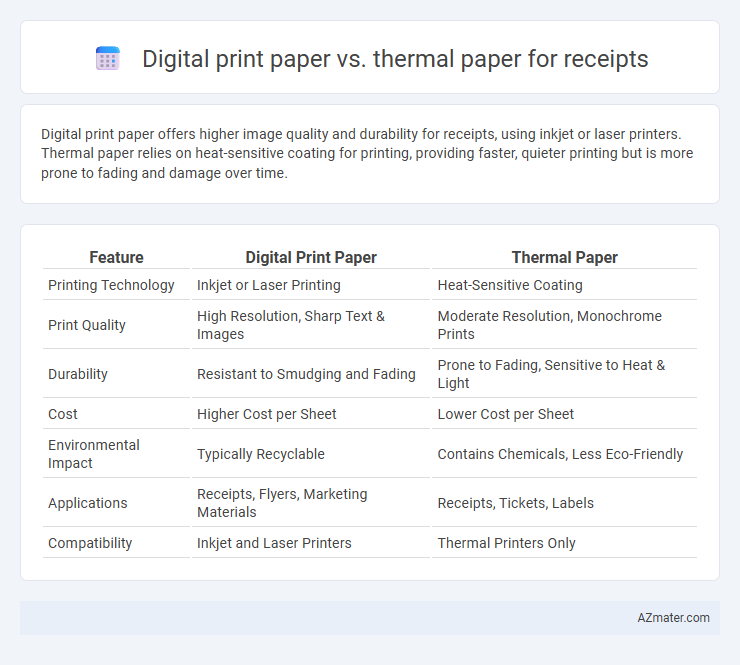Digital print paper offers higher image quality and durability for receipts, using inkjet or laser printers. Thermal paper relies on heat-sensitive coating for printing, providing faster, quieter printing but is more prone to fading and damage over time.
Table of Comparison
| Feature | Digital Print Paper | Thermal Paper |
|---|---|---|
| Printing Technology | Inkjet or Laser Printing | Heat-Sensitive Coating |
| Print Quality | High Resolution, Sharp Text & Images | Moderate Resolution, Monochrome Prints |
| Durability | Resistant to Smudging and Fading | Prone to Fading, Sensitive to Heat & Light |
| Cost | Higher Cost per Sheet | Lower Cost per Sheet |
| Environmental Impact | Typically Recyclable | Contains Chemicals, Less Eco-Friendly |
| Applications | Receipts, Flyers, Marketing Materials | Receipts, Tickets, Labels |
| Compatibility | Inkjet and Laser Printers | Thermal Printers Only |
Introduction to Receipt Paper Types
Digital print paper for receipts utilizes inkjet or laser printers, offering sharp, high-quality text and graphics suitable for detailed logos and promotional content. Thermal paper relies on heat-sensitive coating that darkens when exposed to a thermal printer head, providing fast, low-cost printing without ink or toner. Businesses select digital print paper for durability and color printing, while thermal paper is preferred for speed and cost efficiency in high-volume retail environments.
What is Digital Print Paper?
Digital print paper is specially designed for inkjet and laser printers, offering high-resolution, vibrant prints suitable for receipts requiring detailed graphics or logos. It provides long-lasting durability and resistance to fading, making it ideal for receipts that need to be preserved for record-keeping or returns. Unlike thermal paper, digital print paper requires ink or toner, ensuring consistent print quality without heat sensitivity issues.
What is Thermal Paper?
Thermal paper is a special fine paper coated with a chemical that changes color when exposed to heat, eliminating the need for ink or toner in receipt printing. It is widely used in point-of-sale (POS) systems due to its fast printing speed and high-quality print clarity, especially for receipts and labels. Compared to digital print paper, thermal paper offers cost-effective, maintenance-free operation but can be sensitive to heat, light, and abrasion, which may affect the longevity of printed receipts.
Printing Technology: Digital vs Thermal
Digital print paper uses inkjet or laser printers that apply toner or ink directly onto the paper's surface, producing high-resolution and full-color receipts ideal for detailed logos and graphics. Thermal paper relies on heat-sensitive coatings that change color when exposed to the thermal printhead's heat, enabling faster, quieter, and maintenance-free printing without ink or toner. While digital printing offers versatility and image quality, thermal printing excels in speed, cost-efficiency, and durability for typical receipt generation in retail environments.
Print Quality and Durability
Digital print paper offers crisp, high-resolution images with vibrant colors and fine detail, making it ideal for receipts that require logos or promotional graphics. Thermal paper relies on heat-sensitive coating, producing monochrome prints that are less sharp but cost-effective for high-volume transactions. While digital print paper maintains durability against fading and smudging, thermal paper is prone to discoloration and loss of print quality over time, especially with exposure to heat and light.
Cost Comparison: Digital Print vs Thermal Paper
Digital print paper typically incurs higher costs due to ink or toner usage and requires more expensive printers, whereas thermal paper offers a lower-cost solution with minimal maintenance and no ink expenses. Thermal paper rolls are generally cheaper and widely available, leading to significant savings in high-volume receipt printing environments. Businesses seeking budget-friendly, efficient printing often prefer thermal paper for its cost-effectiveness and ease of use in point-of-sale systems.
Environmental Impact and Sustainability
Digital print paper typically uses soy-based inks and a highly recyclable substrate, reducing environmental toxins and enabling easier recycling compared to thermal paper, which relies on chemical coatings that complicate recycling processes. Thermal paper often contains BPA or BPS, substances linked to health and environmental concerns, whereas digital print paper avoids these harmful chemicals, promoting safer disposal and lower ecological risks. The sustainability of digital print paper is further enhanced by the potential for using recycled fibers and reduced energy consumption in printing, making it a greener choice for receipt production.
Common Applications in Retail and POS
Digital print paper excels in high-resolution, full-color receipts commonly used in retail stores for detailed branding and promotional messages, enhancing customer engagement. Thermal paper dominates POS systems due to its cost-effectiveness and fast printing capabilities, ideal for high-volume transactions like grocery stores, restaurants, and ticketing. Both types ensure efficient receipt generation but differ in durability and compatibility with various printer technologies.
Security and Data Integrity Features
Digital print paper offers enhanced security features such as watermarks, microtext, and ultraviolet (UV) inks that prevent tampering and counterfeiting, ensuring higher data integrity for receipts. Thermal paper relies on heat-sensitive coatings, making it vulnerable to fading, discoloration, and easy alteration over time, which poses significant risks to preserving accurate transactional data. For applications requiring long-term record accuracy and fraud prevention, digital print paper provides superior security and reliability compared to thermal paper.
Choosing the Right Receipt Paper for Your Business
Digital print paper offers high-resolution graphics and vibrant colors ideal for branding and detailed receipts, while thermal paper provides cost-effective, fast printing with durability under normal handling conditions. Selecting the right receipt paper depends on your business needs--digital print paper suits businesses requiring colorful, detailed receipts such as restaurants or retail stores, whereas thermal paper is optimal for high-volume, low-cost printing environments like supermarkets or transport services. Consider factors like print quality, durability, cost per roll, and printer compatibility to ensure efficient operations and enhanced customer experience.

Infographic: Digital print paper vs Thermal paper for Receipt
 azmater.com
azmater.com